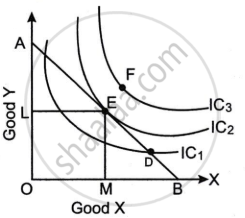Advertisements
Advertisements
प्रश्न
A Consumer consumes only two goods X and Y. Marginal utilities of X and Y is 4 and 5 respectively. The prices of X and Y are Rs 4 per unit and Rs 5 per unit respectively. Is the consumer in equilibrium? What will be the further reaction of the consumer? Explain.
उत्तर
In case of two goods, a consumer strikes equilibrium when,
`(MU_Z)/P_Z=(MU_Y)/P_Y`
Accourding to the given question:
`(MU_Z)/P_Z=5/4=1.25`
`(MU_Y)/P_Y=4/5=0.8`
Since,
`(MU_Z)/P_Z`
is greater than `(MU_Y)/P_Y`
Thus, if a consumer is not in equilibrium, then the consumer increases the consumption of Good X and decreases that of Good Y to reach the equilibrium.
APPEARS IN
संबंधित प्रश्न
A consumer consumes only two goods A and B and is in equilibrium. Show that when price of good B falls, demand for B rises. Answer this question with the help of utility analysis
Given the price of a good, how does a consumer decide as to how much of the good to buy?
A consumer consumes only two goods X and Y. If marginal utilities of X and Y are 4 and 5 respectively, and if price of X is Rs 5 per unit and that of Y is Rs 4 per unit is the consumer in equilibrium? What will be further reaction of the consumer? Explain.
A consumer consumes only two goods X and Y both priced at Rs 3 per unit. If the consumer chooses a combination of these two goods with Marginal Rate of Substitution equal to 3, is the consumer in equilibrium? Give reasons. What will a rational consumer do in this situation? Explain
A consumer consumes only two goods X and Y, both priced at Rs 2 per unit. If the consumer chooses a combination of the two goods with Marginal Rate of Substitution equal to 2, is the consumer in equilibrium? Why or why not? What will a rational consumer do in this situation? Explain.
A consumer consumes only two goods, each priced at Rupee one per unit. If the consumer chooses a combination of the two goods with Marginal Rate of Substitution equal to 2, is the consumer in equilibrium? Give reasons. Explain what will a rational consumer do in this situation.
If equilibrium price of a good is greater than its market price, explain all the changes that will take place in the market. Use diagram.
Market for a good is in equilibrium. There is simultaneous “decrease” both in demand and supply but there is no change in market price. Explain with the help of a schedule how it is possible.
Market for a good is in equilibrium. Explain the chain of reactions in the market if the price is (i) higher than equilibrium price and (ii) lower than equilibrium price.
What are the conditions of consumer’s equilibrium under the indifference curve approach? What changes will take place if the conditions are not fulfilled to reach equilibrium?
From the following schedule find out the level of output at which the producer is in equilibrium, using marginal cost and marginal revenue approach. Give reasons for your answer.
|
Price per unit (Rs) |
Output (Units) |
Total Cost (Rs) |
|
8 |
1 |
6 |
|
7 |
2 |
11 |
|
6 |
3 |
15 |
|
5 |
4 |
18 |
|
4 |
5 |
23 |
What can lead to change in budget set?
Identify the correctly matched pair from Column A to that of Column B:
| Column A | Column B | ||
| (1) | Investment Multiplier | (a) | C + I + G + (X − M) |
| (2) | Marginal Propensity to Consume | (b) | `(ΔC)/(ΔY)` |
| (3) | Marginal Propensity to Save | (c) | `(ΔI)/(ΔY)` |
| (4) | Aggregate Demand | (d) | `(ΔS)/(ΔY)` |
What is the saturation point?
Refer to the diagram given below and answer the questions that follow.

- What does the line AB represent? Why is the line AB negatively sloped? (2)
- At which one of the given points, D, E and F, will the consumer attain equilibrium? Explain. (2)
- Briefly explain why the consumer is not in equilibrium at the other two points. (2)
